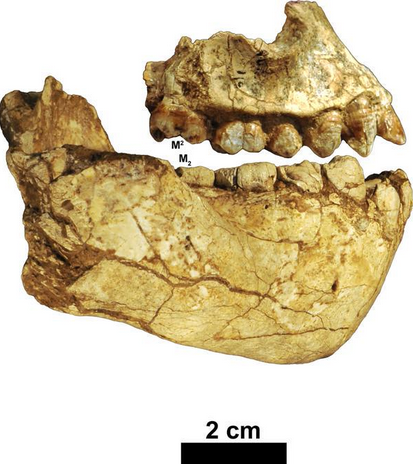 |
| The tangled web of our evolutionary origins |
When hominin fossils were few and far between, there appeared to be a precise chain of a few key species linking the first members of the genus Homo with more primitive hominin ancestors.
In the past 50 years, however, a plethora of new fossils has turned what was once a neat, straight line progression into a tangled web of species all vying for the title of human ancestor. Enter a new species of Australopithecus.
An international team of researchers, led by Dr Yohannes Haile-Selassie from the Cleveland Museum of Natural History, uncovered a series of upper and lower jaws from 3.3 to 3.5 million year old sediments in the Woranso-Mille area of Ethiopia's Afar Triangle, a region known for previous hominin fossil discoveries. Several features, including a robust jaw architecture, thick tooth enamel and small anterior teeth, helped to distinguish the fossil from existing species of australopithecines.
The closest match was to Australopithecus afarensis, the species Lucy, our ancestor, is from. However, the shape of the teeth indicated this creature had a different diet to that of Australopithecus afarensis. As such it was placed in an entirely new species, Australopithecus deyiremeda, the specific epithet deriving from the language of the Afar people, translating as 'close relative'. The specimens were discovered just 22 miles north of the Hadar site where Lucy was found, suggesting that the two species may have coexisted.
 |
| The 3.3 to 3.5 million year old jaws of the new hominin species Australopithecus deyiremeda |
The discovery of a 3.4 million year old partial fossil foot from Burtele, Ethiopia, suggested that multiple hominid species lived alongside Lucy, but its fragmentary nature meant it could not be conclusively classified. The new jaws, however, confirm that Lucy is one amongst several potential ancestors living at that time.
'This new species from Ethiopia takes the ongoing debate on early hominin diversity to another level,' said Haile-Selassie. 'Some of our colleagues are going to be sceptical about this new species, which is not unusual. However, I think it is time that we look into the earlier phases of our evolution with an open mind and carefully examine the currently available fossil evidence rather than immediately dismissing the fossils that do not fit our long-held hypotheses'.
It is important that ideas do not become fixed. Lucy supplanted the first australopithecine discovery, Australopithecus africanus, as the likely candidate for our ancestor. With the new influx of species from places like Ethiopia, the view on how human evolution has progressed is less straightforward.